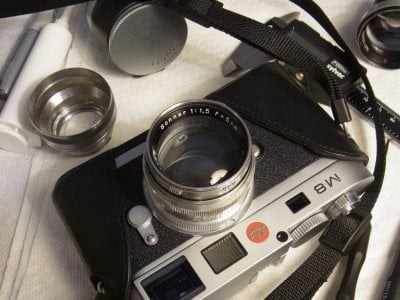markjwyatt
Well-known
Playing around with old lenses, waiting for spring flowers to appear soon. A 1951 Jupiter-9 in LTM. CZJ serial number on rear lens group.
The CZJ serial number (2)851104 appears in Harmut Thiele's book as part of a batch of 2,000 8.5cm/2 lenses completed February 6, 1946. I also have two CZJ 85/2 lenses in LTM from the same batch
I have Thiele's book, and that serial number range without the "2" in front is for a 15 cm f4.5 Tessar for the Zeiss Ikon Ideal (1928ish)- not consistent. Why do you think there is a 2,000,000 attached to this? For 2,851,104 I do see the 85mm f2 Sonnar. In your LTM 85/2s do they drop the "2" in front?
Last edited:
Zeiss did not stamp the entire SN in all of the fixtures, just the last digits. I've seen 4, 5, and 6 digits stamped in the inner fixtures.I have Thiele's book, and that serial number range without the "2" in front is for a 15 cm f4.5 Tessar for the Zeiss Ikon Ideal (1928ish)- not consistent. Why do you think there is a 2,000,000 attached to this? For 2,851,104 I do see the 85mm f2 Sonnar. In your LTM 85/2s do they drop the "2" in front?
"5cm F1.5 Sonnar Conversion 29". Did this one in 2012. I've done almost 60 of these.
Lots of Twos. Three Twos on the front ring, Two Twos on back.
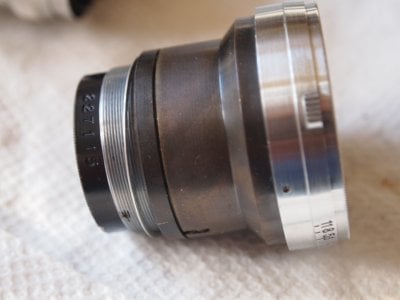
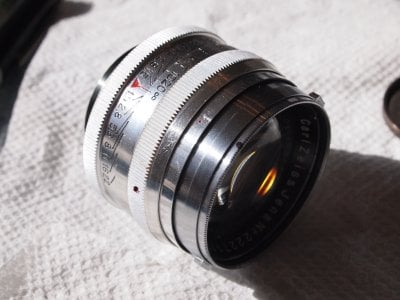
Last edited:
dexdog
Mentor
I have seen just the last 6 digits on rear lens groups. The dozen or so that I have successfully taken apart and reassembled have various numbers of digits stamped on the inner fixtures as Brian has noted.
markjwyatt
Well-known
I guess it was "work-in-progress". Everyone knew where they were in terms of millions... On the lens front the full serial number is needed.
The Serial Numbers stamped on inner fixtures are used to match the components of the lens. When the Russians completed assembly of the early Jupiters using Zeiss components, new name rings were made with the KMZ SN scheme. The inner serial numbers remained, out of sight. Disassembling the lens- having the inner serial number is good confirmation of Zeiss manufacture and gives the lot number.
dourbalistar
Buy more film
I'm not sure if this is actually rare, but I think it's uncommon. Perhaps the Head Bartender or a resident Cosina-Voigtlander expert could confirm or shed some light. Most other examples I have seen of the early 107-SW (aka Voigtlander Bessa-L) have the Cosina badge engraved on the front plate. My copy has no branding, only the model name - I don't think it's been altered. For what it's worth, I bought this off the Big Auction site from a seller in Mexico. An entry on the Camerapedia wiki notes that:

Cosina 107-SW aka Bessa L by dourbalistar, on Flickr
In Asia, the Voigtländer Bessa L was first sold as the Cosina 107-SW in a limited number and hence this version is slightly rarer to find today.

Cosina 107-SW aka Bessa L by dourbalistar, on Flickr
TenEleven
Well-known
For the record, in the camera stores in Tokyo as well as online I have seen many many "Bessa L" and some, much less, "Cosina 107-SW" - I have however never seen a body that omits the "Cosina" branding, so yes this is likely to be rare. And kind of cool.
I wonder if this might be a "tweener" camera where they were changing the branding to "Voigtlander" but had not yet decided on a name for the camera, yet...
I wonder if this might be a "tweener" camera where they were changing the branding to "Voigtlander" but had not yet decided on a name for the camera, yet...
TenEleven
Well-known
To add something of my own... or rather something I have spotted, but did not buy because frankly the asking price was outrageous. (Around $900) Insult to injury the card said it did not focus right, which did not surprise me at all since the lens is sat too far back in my view. It would have needed to go much closer to the film plane for a Sonnar.
I'd have considered seeing if I can fix this sick puppy, or rather complete the work of making it into a Leica lens, if the asking price was maybe 1/3rd or 1/4th of what it was. The glass was in nice condition...
If I had a guess I think the donor in this case was either a Summar or a Summitar.
The latter seems more likely, but I am not a Leitz expert.
None the less I thought it was interesting, it is sort of the "brother" version to my mounted in a Summarit shell CZ (post war) Sonnar 50/1.5. In both cases the DOF scale will be correct, which I guess is a nice touch. Here's some pictures so you can see how it was done.
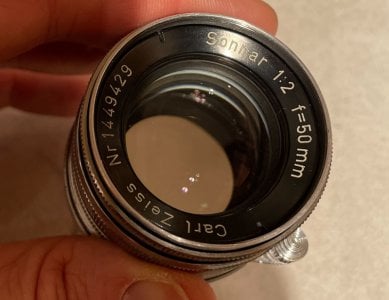
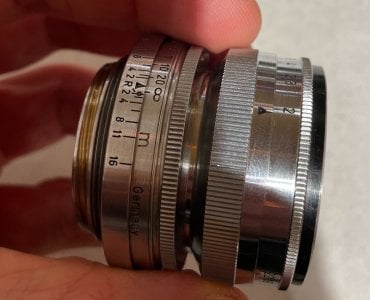
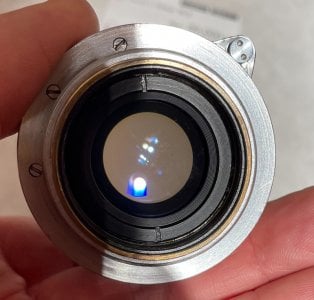
I'd have considered seeing if I can fix this sick puppy, or rather complete the work of making it into a Leica lens, if the asking price was maybe 1/3rd or 1/4th of what it was. The glass was in nice condition...
If I had a guess I think the donor in this case was either a Summar or a Summitar.
The latter seems more likely, but I am not a Leitz expert.
None the less I thought it was interesting, it is sort of the "brother" version to my mounted in a Summarit shell CZ (post war) Sonnar 50/1.5. In both cases the DOF scale will be correct, which I guess is a nice touch. Here's some pictures so you can see how it was done.



JakobN
JakobN
Here are an uncommon and a very uncommon 5cm f2 Sonnar. I believe these lenses have been altered from Contaflex mount to Contax mount before leaving the factory, maybe due to less than expected demand for the Contaflex camera. I can not be sure as I do not have a Contaflex lens. These two types occur in batches with many regular Contaflex lenses, in the front they look the same. The first has the deep set front lens already seen in the last nickel version (and in the rigid chrome that milescl presented 10 days ago), the second looks like the common collapsible for Contax but the front lens and the bezel with the lettering are recessed in the mount. Of the lens on the left I have seen 34 copies in my 20+ years of searching for Sonnars, whereas of the variant on the right I have only seen two.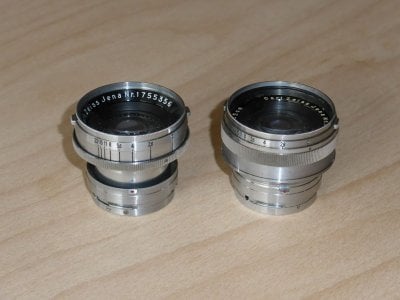

markjwyatt
Well-known
The one on the right (The one I can see the serial number for) is from a batch of 400 Contax lenses lenses that include some Contaflex lenses per Halmut Thiele. There were four batches of 3000 Contax lenses made in 1935, your lens was part of them. 600 were retractable, of the Of your batch of 400 and the first batch of 1000 for 1935, some Contaflex lenses were included. The Contax II was released in 1936. The Contaflex was produced in 1935.Here are an uncommon and a very uncommon 5cm f2 Sonnar. I believe these lenses have been altered from Contaflex mount to Contax mount before leaving the factory, maybe due to less than expected demand for the Contaflex camera. I can not be sure as I do not have a Contaflex lens. These two types occur in batches with many regular Contaflex lenses, in the front they look the same. The first has the deep set front lens already seen in the last nickel version (and in the rigid chrome that milescl presented 10 days ago), the second looks like the common collapsible for Contax but the front lens and the bezel with the lettering are recessed in the mount. Of the lens on the left I have seen 34 copies in my 20+ years of searching for Sonnars, whereas of the variant on the right I have only seen two.View attachment 4818504
JakobN
JakobN
Thank you MarkThe one on the right (The one I can see the serial number for) is from a batch of 400 Contax lenses lenses that include some Contaflex lenses per Halmut Thiele. There were four batches of 3000 Contax lenses made in 1935, your lens was part of them. 600 were retractable, of the Of your batch of 400 and the first batch of 1000 for 1935, some Contaflex lenses were included. The Contax II was released in 1936. The Contaflex was produced in 1935.
Räuber
Established
The left one looks to be a kind of v1 collapsible design. You can find it in batches 28 - 30 all from 1935. Those batches are shared between the nickel black ring round Sonnar 5cm F2, the later v2 collapsible design, some Contaflex Sonnar 5cm F2 and this v1 collapsible design. One has to admit that the Sonnar 5cm F2 production spawns even more designs and production run inconsistencies as the Sonnar 5cm F1.5 production.Here are an uncommon and a very uncommon 5cm f2 Sonnar. I believe these lenses have been altered from Contaflex mount to Contax mount before leaving the factory, maybe due to less than expected demand for the Contaflex camera. I can not be sure as I do not have a Contaflex lens. These two types occur in batches with many regular Contaflex lenses, in the front they look the same. The first has the deep set front lens already seen in the last nickel version (and in the rigid chrome that milescl presented 10 days ago), the second looks like the common collapsible for Contax but the front lens and the bezel with the lettering are recessed in the mount. Of the lens on the left I have seen 34 copies in my 20+ years of searching for Sonnars, whereas of the variant on the right I have only seen two.View attachment 4818504
The right one is pretty rare as you already stated. I have seen 2 in one year. With yours I have seen 3. Edit: I recognized your posting in the other thread with 24 / 55 serial numbers of this lens design. Looks like this all chrome rigid design was a common design before the full switch to the collapsible designs. The barrel looks similar to the Sonnar 5cm F1.5 all chrome one that was produced from May 1935 until 1940. Makes sense that they switched to this design for a short period of time.
Here are 2 findings from Ebay.
1.659.167
This single one comes from a batch of Sonnar 5cm F2 from March 1935 that contains nickel black ring round Sonnar 5cm F2 and Contaflex Sonnar 5cm F2.
1.866.371
Another single lens from a batch of Sonnar 5cm F2 from May 1935 that contains v2 collapsible F2 Sonnars and Contaflex Sonnar 5cm F2.
Last edited:
dexdog
Mentor
Set of Canon 55mm filters for the 50/1.2 lens. These filters are easy to recognize because the front surface of the filter glass is flush with the aluminum filter ring. As Sonnar B has noted, the front lens element of the 50/1.2 bulges out a bit and needs either these filters or a step-up ring/spacer to avoid hitting the front lens element when attaching the filter. This arrangement leaves no female threads on the front of the filter, which is why the hood for the lens is a clamp-on type.




Last edited:
JakobN
JakobN
Thank you, RaüberThe left one looks to be a kind of v1 collapsible design. You can find it in batches 28 - 30 all from 1935. Those batches are shared between the nickel black ring round Sonnar 5cm F2, the later v2 collapsible design, some Contaflex Sonnar 5cm F2 and this v1 collapsible design. One has to admit that the Sonnar 5cm F2 production spawns even more designs and production run inconsistencies as the Sonnar 5cm F1.5 production.
The right one is pretty rare as you already stated. I have seen 2 in one year. With yours I have seen 3. Edit: I recognized your posting in the other thread with 24 / 55 serial numbers of this lens design. Looks like this all chrome rigid design was a common design before the full switch to the collapsible designs. The barrel looks similar to the Sonnar 5cm F1.5 all chrome one that was produced from May 1935 until 1940. Makes sense that they switched to this design for a short period of time.
Here are 2 findings from Ebay.
1.659.167
This single one comes from a batch of Sonnar 5cm F2 from March 1935 that contains nickel black ring round Sonnar 5cm F2 and Contaflex Sonnar 5cm F2.
1.866.371
Another single lens from a batch of Sonnar 5cm F2 from May 1935 that contains v2 collapsible F2 Sonnars and Contaflex Sonnar 5cm F2.
boojum
Mentor
Obscure or rare? Hmmm. I picked up an X2D with the HB XCD 55V 55mm lens and am pretty much done shopping for cameras and lenses. The IQ and color are wonderful, 15 stops of dynamic range, 16bit color and 7 stop IBIS. I really love the M9 with the Amotal or one of my lovely Jupiter 8's but this HB combo really had gotten my attention. Here is a link. X2D
brusby
Well-known
Very nice, Brian!
Regarding lenses like the Jupiter 3s, how are you handling the changed index mark for aperture after you shim them for Leica? Are you drilling new holes for the three little screws so the mark can sit up top as originally designed or just putting a new temporary one on the side where it comes to rest?
Regarding lenses like the Jupiter 3s, how are you handling the changed index mark for aperture after you shim them for Leica? Are you drilling new holes for the three little screws so the mark can sit up top as originally designed or just putting a new temporary one on the side where it comes to rest?
Last edited:
I use a hand drill- and three different Bits to get the new taps for the J-3 for the aperture index.Very nice, Brian!
Regarding lenses like the Jupiter 3s, how are you handling the changed index mark for aperture after you shim them for Leica? Are you drilling new holes for the three little screws so the mark can sit up top as originally designed or just putting a new temporary one on the side where it comes to rest?
And even more difficult- when I need to reset the helical into the mount, as lens does not reach infinity- make new holes to hold the focus ring in place as well.
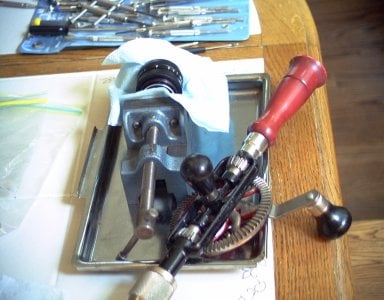
Last edited:
The rarest Jupiter-3 of all.
A Good Valdai.
That needed LOTS of work. The earlier J-3, up until 1963 or so- the aperture ring screwed in. Later ones, only the set screws hold in place. SO- you need to Tape and Drill.
Start the new Taps through the holes, then remove the ring and drill with larger taps. Otherwise- you strip the threads of the holds.
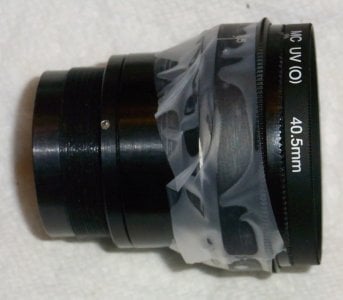
I had to grind the mount down, and screw the helical in deeper- meaning re-align the focus ring as well.
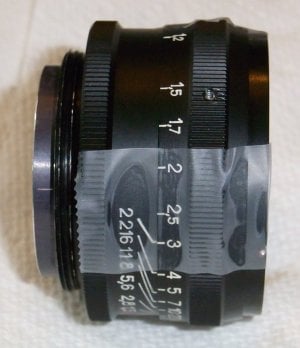
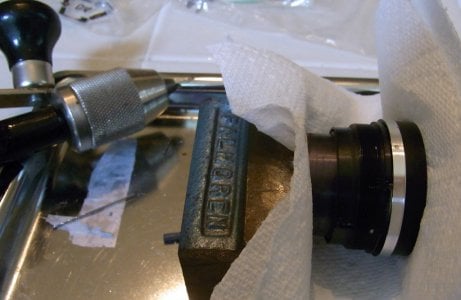
And make new taps in the underlying focus mechanism.

Wide-Open.
The only Sharp Valdai J-3 that I've ever seen.
A Good Valdai.
That needed LOTS of work. The earlier J-3, up until 1963 or so- the aperture ring screwed in. Later ones, only the set screws hold in place. SO- you need to Tape and Drill.
Start the new Taps through the holes, then remove the ring and drill with larger taps. Otherwise- you strip the threads of the holds.

I had to grind the mount down, and screw the helical in deeper- meaning re-align the focus ring as well.


And make new taps in the underlying focus mechanism.

Wide-Open.
The only Sharp Valdai J-3 that I've ever seen.

brusby
Well-known
I use a hand drill- and three different Bits to get the new taps for the J-3 for the aperture index.
Sounds like a good technique.
And even more difficult- when I need to reset the helical into the mount, as lens does not reach infinity- make new holes to hold the focus ring in place as well.
My 1950 J3 is spot on at infinity. But I have a 1952 J3 that has the opposite issue than you are describing. It focuses just a shade past infinity. It's so minor that I may not mess with it, but it is more satisfying to use a lens that is set up correctly. I haven't yet figured our why the two would be different. Oddly the two lenses look remarkably similar.
Yep, both my 1950's screw in.... The earlier J-3, up until 1963 or so- the aperture ring screwed in. Later ones, only the set screws hold in place. SO- you need to Tape and Drill.
Start the new Taps through the holes, then remove the ring and drill with larger taps. Otherwise- you strip the threads of the holds.
thanks!
Share:
-
This site uses cookies to help personalise content, tailor your experience and to keep you logged in if you register.
By continuing to use this site, you are consenting to our use of cookies.




